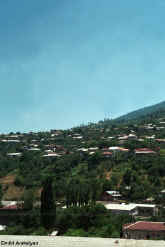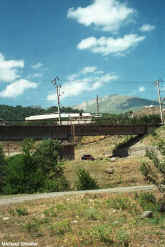|

|
First
after Sevan
Pass is
Dilijan,
was a major summer resort in Soviet times, blessed with a cool,
moist climate, even in summer, and pleasant evergreen forests
protected, in principle, by a large nature reserve that wraps
around the town and extends along the SW bank of the Getik
river.
There are hotels, pensionats, and
bed & breakfasts of various descriptions, |
|
Continuing
E
on
the
Ijevan
road another 0.8 km, an unmarked paved road
ascends steeply left under the railroad tracks near the village
of
Teghut
and
into a lovely wooded stream valley with picnic areas,
khachkars,
culminating in Haghartsin
Monastery, one of Armenia’s most evocative.
After passing the
decaying
remains
of an
ill-advised cable car,
|

|
|
most notably the “Lernayin Hayastan”
resort
on the ridge S of town, formerly a spa for Soviet nomenklatura
families, now controlled by the Defense Ministry but often
available for tourists or seminars.
There is an ethnographic museum and a row of early 20th
c. houses now serving as a museum.
Dilijan is rich in prehistoric tombs, including the
Golovino Early Iron Age site 3 km on the Sevan road, and
Redkin
Lager Iron Age site 3 km along the Ijevan road on the Aghstev
river.
From
the main Dilijan roundabout 3.2 km W of Dilijan on the Vanadzor
(upper left) road, the N fork of a small roundabout leads under
the orange railroad bridge about 2.7 km to the ornate iron gates
of the Dilijan mineral water factory (less salty than Jermuk,
this recently revived table water was in early 1999 trying to
recapture a share of the Yerevan bottled water market).
A dirt road (impassible to cars due to landslides) leads
up to the right to (10 minutes on foot) Jukhtak
Vank, nestled in an attractive forest grove with picnic
tables.
The near church, St. Grigor, was built probably in the 11th
or 12th c.
The dome disappeared long ago, and the foundation and
walls have been brutally reinforced with concrete against the
collapsing soft stone below.
On the
wooded slope somewhere opposite is Matosavank
monastery.
The small church, dedicated to S. Astvatsatsin of Pghndzahank
and dated 1247, was built under Avag Zakarian, son of Ivane,
after he had pledged submission to the Mongols and become
Georgian/Armenian military leader for Mangu Khan, grandson of
the great Genghis. Continuing W on the potholed but adequate
former traffic artery paralleling the Aghstev river and railroad
line, one soon enters Lori Marz bound for Vanadzor and Gyumri.
Taking
the road E from Dilijan, one reaches in 6.7 km the turn-off
right (sign-posted in Armenian) for Parz
Lich
(“Clear Lake”). Cross the bridge over the Aghstev, bearing W, then take
the left fork, which winds through about 8 km of forest to end
at a modest green lake, banks slightly muddy (beware ringworm)
but excellent for a picnic and forest hikes in a quiet,
non-typical setting.
|
|
note funerary shrines with khachkars. Reaching the
Haghartsin
monastic complex proper,
first building on the left is the large vaulted dining room of
1248, one of only two such in Armenia (the other at Haghpat),
beyond which is a ruined service building with working oven.
The gavit (end
of 12th c.) was built at the behest of Ivane Zakarian
against the small domed 10th c. church of S. Grigor.
The small S. Stepanos church of 1244 is behind.
S. Astvatatsin church on the right, built or rebuilt in
1281, has high on the outside of the E wall a donation relief
sculture showing the Zakarian brothers. Though the churches are
locked, a local caretaker has the keys.
Five
km N of Teghut were found and taken to the museum two Aramaic
inscriptions of Artashes I (189-160 BC).
|